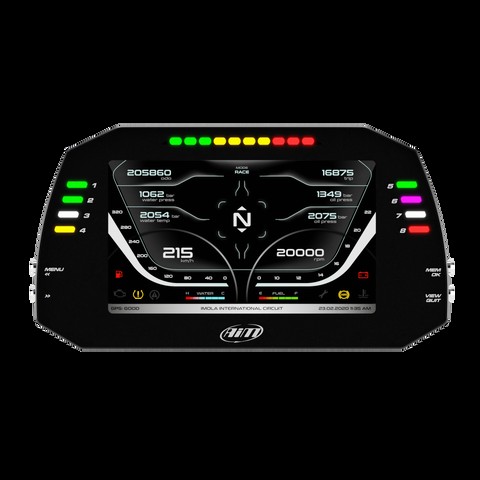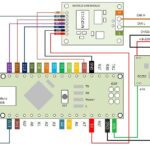Looking to enhance your vehicle’s data monitoring and display capabilities? The AiM MXG 1.3 Strada 7″ TFT Dash Display is a game-changer, offering a vibrant and comprehensive interface for all your car’s essential information. This guide delves into the features and benefits of this advanced digital dash, focusing on its seamless OBD2 connectivity and superior performance.
What sets the AiM MXG 1.3 Strada apart is its ability to effortlessly integrate with your vehicle’s OBD2 port. OBD2 (On-Board Diagnostics II) is a standardized system in most modern cars and light trucks, providing access to a wealth of data from the engine control unit (ECU). With the AiM MXG 1.3 Strada, you can tap into this data stream to display crucial parameters right in your line of sight, improving both your driving experience and vehicle understanding.
Key Features and Benefits of the AiM MXG 1.3 Strada OBD2 Dash
This 7-inch TFT display is not just visually impressive; it’s packed with features designed for both performance enthusiasts and everyday drivers:
- Large 7″ TFT Color Display: Provides excellent readability and visual impact, ensuring you can easily see critical data at a glance.
- OBD2 or CAN Connection: Offers versatile connection options, with a focus on easy OBD2 integration for straightforward setup.
- Configurable Data Display: Customize what information you want to see, from RPM and speed to temperatures, pressures, and much more, pulled directly from your ECU via OBD2.
- Alarm and Shift Lights: Features 8 configurable RGB alarm LEDs and 10 shift light RGB LEDs to alert you to critical conditions or optimal shift points.
- Analogue and Digital Inputs: Expands functionality beyond OBD2 data with 8 analogue inputs and 6 digital inputs for connecting additional sensors if needed.
- CAN Output: Allows for sending data to other CAN networks, further extending your vehicle control and data logging possibilities.
- User-Friendly Configuration: Set up and customize your display pages, alarms, and shift lights easily with intuitive software.
Easy OBD2 Connection and Data Acquisition
One of the standout features of the AiM MXG 1.3 Strada is its ease of connection to your vehicle’s OBD2 port. This simplifies installation dramatically, as you can access a wide range of ECU data with just a few cable connections. Instead of wiring in numerous sensors, the OBD2 connection allows you to sample and display dozens of channels directly from your car’s computer.
The specific data available depends on your vehicle’s ECU capabilities but typically includes essential parameters such as:
- RPM
- Speed
- Throttle Position (TPS)
- Coolant Temperature
- Oil Temperature
- Oil Pressure
- Battery Voltage
- Gear Position
- Lambda Value (Air/Fuel Ratio)
AiM boasts an extensive and continuously updated list of over 1000 compatible ECU drivers, ensuring broad vehicle compatibility. This makes the MXG 1.3 Strada a versatile OBD2 dash solution for a wide range of cars.
Advanced Display and Customization for Optimal Information
The MXG 1.3 Strada’s 7″ high-contrast TFT display is designed for optimal visibility in all lighting conditions. An ambient light sensor automatically adjusts the backlight brightness, preventing glare in bright sunlight and ensuring clear readability at night.
Pre-configured pages display essential data like RPM, speed, temperatures, pressures, and lap times right out of the box. However, the real power lies in its customization. You can easily create custom pages to display the exact data you need, in your preferred layout, with up to four additional data fields per page. Define scales, units of measurement, and easily switch between pages using pushbuttons for a tailored driving experience.
Furthermore, the flexible RGB shift lights and alarms are highly configurable. Customize the ten multi-colored shift lights based on RPM thresholds, ECU values, or other data sources. Choose colors, flashing patterns, and even accompanying text messages to create a highly personalized and informative alert system. Prioritize alarms to ensure you never miss critical warnings.
Expandability and Powerful Software Suite
Beyond its core OBD2 capabilities, the AiM MXG 1.3 Strada offers expandability to grow with your needs. Two digital outputs can be configured to control external systems based on input values – for example, activating cooling fans or auxiliary lights automatically. CAN output allows for integration with existing vehicle CAN networks for even more control possibilities. Camera inputs allow for integrating mirror camera functionality, enhancing safety and visibility (cameras sold separately).
To unlock the full potential of your AiM MXG 1.3 Strada OBD2 dash, the included Race Studio 3 software is essential. This powerful software suite allows for:
- Configuration: Create, modify, and manage display configurations, ECU drivers, math channels, alarms, shift lights, and more.
- Analysis: Download and analyze data logged by the MXG Strada to gain insights into vehicle performance. Visualize data with graphs, histograms, and tables to identify areas for improvement.
- Track Mapping: Manage your racing track maps and compare lap data, especially when combined with SmartyCam HD camera footage.
The AiM MXG 1.3 Strada 7″ TFT Dash Display is more than just a gauge cluster; it’s a comprehensive vehicle data center that enhances your driving experience and provides valuable insights into your car’s performance. Its easy OBD2 connectivity, customizable display, and powerful software make it an ideal upgrade for anyone looking to take their vehicle monitoring to the next level. Explore the AiM MXG 1.3 Strada and discover how it can transform your ride.
[

